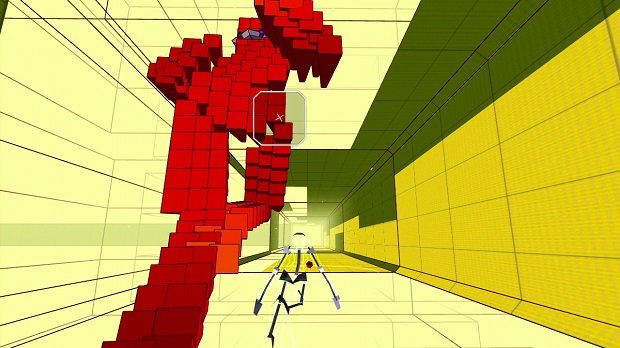Sony's already doing meetings in PlayStation VR… and other tidbits we learned at GDC 2016
The annual Game Developers Conference in San Francisco is a mecca for people who make games, where they can share and exchange information on their own creative process. Every year, dozens of fascinating panels illuminate the behind-the-scenes struggles of big-budget console games and breakout indies, with developers sharing their insights on what went well, and what flat-out failed. But not everyone can make it out to GDC to attend these informative talks in person - and even if you can, there's not enough time in the day to see everything you want.
Fear not - we're here to share some of our favorite game-design secrets, tidbits, and facts we learned while attending some particularly fascinating talks this year. You'd need a hyperbolic time chamber to see all the intriguing panels and exciting console games at GDC 2016, but if you share these bits of game trivia with your friends, it'll almost be like you were there!
Battle.net originally ran off a single computer
Nowadays, the online servers powering your favorite multiplayer games consist of dozens (if not hundreds) of computers strewn together in a gigantic room. But way back in the day - 1996, to be exact - the kinds of computations that make multiplayer possible could be relegated to a single desktop. In his fascinating postmortem talk on the making of the original Diablo, David Brevik revealed the surprisingly modest requirements for running the original iteration of Battle.net, Blizzard's trademark online service. The nitty-gritty explanation involves peer-to-peer PC gaming wizardry, but the very notion that one single computer powered hours and hours of online demon-slaying fun is flabbergasting. And here's another fun fact: Diablo's distinct visual style was directly inspired by the claymation beasts from Primal Rage.
Assassin's Creed: Syndicate's London contains nearly 8,000 virtual buildings
As you can probably imagine, building an entire open-world city for a blockbuster series like Assassin's Creed is no easy feat. Ubisoft's Damien Bastian went into great detail about how Assassin's Creed Syndicate's sprawling version of London came to be, citing some nifty statistics to help provide a sense of scale: there are just short for 8,000 buildings in total, 804 intersections, and nearly 50 miles of road that you and the citizens can traverse. Fortunately for the development team's sanity, those thousands of buildings didn't have to each be constructed by hand; most were generated from a set of interchangeable props, with pieces of buildings divided into the front, back, roof, basement, garden, and parkour elements.
Lara Croft GO's animations effectively trick your brain
If you've played Lara Croft GO, then you know how well it manages to somehow capture the essence of Tomb Raider's fast-paced action and adventure even as a turn-based puzzle game (and if you haven't played it, you should really get on that). In his postmortem talk on the app, technical director Antoine Routon explained that Lara's snappy animations are a crucial part of what makes the gameplay feel like it retains a sense of urgency, even though you have all the time in the world to make your next move. Lara's movements are extremely quick, and playtesting found that even the slightest details - like the animation of the ground crumbling underneath Lara's feet, or a door sliding shut little by little - spurred players to swipe towards their destination even quicker, despite the fact that they were never pressured by any actual time limits.
No emulator has ever been ruled illegal in a court of law
In a panel about debunking the taboo of emulators, which the games industry has demonized for decades, presenter Frank Cifaldi put forth some great arguments toward the industry embracing the emulation of old games rather condemning it. The primary argument was toward preservation of classic games. Many retro games aren't available for purchase unless they're part of (or replaced by) a remake, and even collector's editions often use imperfect ports rather than the unmodified original works. Cifaldi also pointed out two major court cases involving emulation, both involving commercial PS1 emulators: Connectix Virtual Game Station for Mac, and bleem! for PC. In both instances, Sony actually lost the case, in which the courts ruled that the development of emulation software is classified as fair use, rather than copyright infringement. Who knew!
The Rez development team attended raves as research
Nearly 15 years after Rez originally debuted on Dreamcast and PlayStation 2, producer and team leader Tetsuya Mizuguchi gave an enlightening look at how he first created its concept, and how it was realized as the synesthesia-simulating shooter that's been a cult classic ever since. One of the key takeaways from the Rez postmortem is how much of the development team's time and effort went into discovering the essence of "being in a groove" - the kind of experience you might have at a techno rave. Mizuguchi reminisced how inspired he was during a 1997 trip to the EDM-centric Street Parade music festival in Zurich, Switzerland, and how he insisted that everyone on the development team (even the wallflowers) go out clubbing to experience the kind of rhythm and dynamic atmosphere that a skilled DJ can create. The team even found guidance in some footage shot by a team member during a trip to Kenya, in which a street performance slowly grows into a joyous crowd. Mizuguchi recalls watching the short clip thousands of times as he studied what exactly it was that compelled these people to get their groove on.
Sign up to the GamesRadar+ Newsletter
Weekly digests, tales from the communities you love, and more

Sony's PlayStation VR team has its global meetings in a virtual world
At the end of the PlayStation VR panel, the team showed off one of its concept virtual worlds that allowed players to embody a cartoony avatar and explore a wacky virtual playground. After showing the audience a humorous display of snowball fights, table tennis, and virtual cliff diving, the presenters revealed that the test world was often how the global team joined together to talk business. Now that I think about it, it would be great to be able to throw berries in your coworkers' faces or throw them off a cliff in the middle of a business meeting.
Realism is really hard to pull off in VR
What's different about creating a VR game is the need to pay really close attention to details. Because you're placing a person in a new, virtual world, that world needs to replicate the real one to keep players from becoming disoriented. And, as you might imagine, that is really, really hard to do. People's brains subconsciously know what it should feel like to see objects and interact with them in a space, so if one thing is off, like inertia from moving, or lag from moving your view, you can make someone puke. This makes realistic experiences difficult in VR and may be a significant reason for a developer to create more outlandish, magical, and unrealistic VR experiences.
Lucas Sullivan is the former US Managing Editor of GamesRadar+. Lucas spent seven years working for GR, starting as an Associate Editor in 2012 before climbing the ranks. He left us in 2019 to pursue a career path on the other side of the fence, joining 2K Games as a Global Content Manager. Lucas doesn't get to write about games like Borderlands and Mafia anymore, but he does get to help make and market them.



